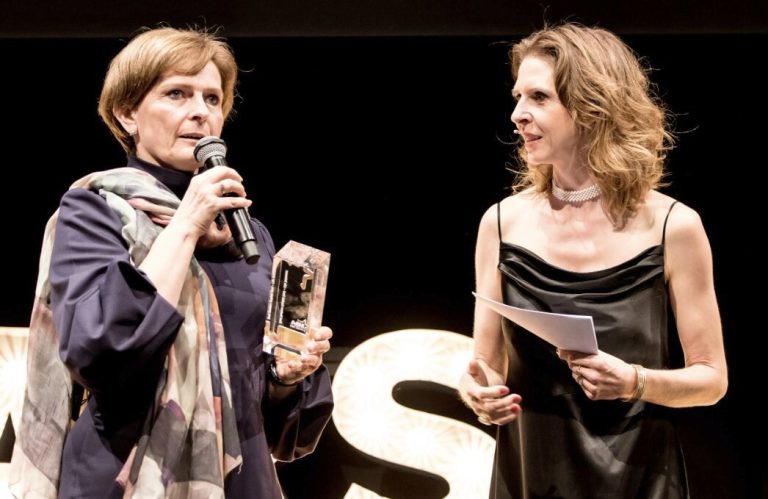Precirix, best Belgian VC deal of the year: ‘Round completed just before the crisis.’

In an interview with House of Executives Belgium, CEO Ruth Devenyns reveals Precirix’s vision to shape a transformation in the treatment of cancer through this capital round.
It’s an art to be able to explain simply what is happening in the biotech world, but Ruth Devenyns, CEO of Precirix, does it masterfully: “We are in the sector of new drugs to fight cancer. What we do is irradiate cancers from the inside, through the administration of a drug. So, the patient is not irradiated via a machine but through a drug that fights cancer at the cellular level.”
This technology is not new. Around the turn of the century, the first radioactive drugs were launched but without real commercial success. In recent years, there have been several successful product launches that have led to a true revival in this biotech domain.
The connection between camels and biotech
In the 1990s, it was discovered at the VUB that the tiny antibodies of camelids are very valuable for various applications, including in the pharmaceutical industry. Several companies have worked on this finding in recent years, with Ablynx (now owned by Sanofi) being the most well-known.
“Precirix is a spin-off from the VUB, founded in 2014 by a group of scientists as a side project of their academic careers. I joined in 2017. At Precirix, the antibodies of camelids are used as tracers that can very precisely detect, bind to, and deliver a radioactive payload to cancer cells in the body, while the unbound fractions quickly leave the body. Today, our vision is to bring about a transformation in the treatment of solid tumors. We want to help make a new treatment mainstream.”
What makes Precirix unique is the deep scientific approach to oncological treatments. They start from very thorough university knowledge and develop an innovative approach to create an optimized, new drug. “There are other companies developing these types of drugs, but they start from a different foundation and are often led by people with production expertise. They tend to focus more on the production of their own drug and less on the innovation process, which is the basis for further development for us, based on our knowledge of camel antibodies on the one hand and the radioactive linkage on the other,” explains Ruth.
Not a one-hit wonder
To understand how the raised 80 million will strengthen the Precirix story, Ruth looks back at the previous capital round (37 million euros in 2018): “At that time, we brought our project out of its virtual existence: we prepared a number of things that would allow us to effectively test products from labs on humans. The scale and quality had to be taken to a higher level, and regulatory approvals were a must.” For such approvals, Precirix needed a detailed supporting dossier with data.
Today, our vision is to bring about a transformation in the treatment of solid tumors. We want to help make a new treatment mainstream.
The first funds were mainly used to optimize the production process and design the study. Ruth continues: “With the second round, we want to progress with the clinical study and expand our portfolio further. We want to prove that we are not a one-asset company, let alone a one-hit wonder: we want to show that what we do has platform value, so that it can be replicated into new products. Now it’s about proving that the product really makes people better, that there are no harmful side effects, and that we can create new drugs for other types of cancer following the same principle.”
Canadian Ecosystem
Because Precirix does not have the infrastructure for it in Belgium or Europe, they went looking for a partner to fine-tune the production process a few years ago. Ruth explains why Canada: “In Canada, there is a local hub with experience that provides proximity to hospitals. At that time, we asked ourselves how we would ship a radioactive drug with limited shelf life to possibly test it in Europe. We decided to keep the product in Canada to test it there. We obtained approval from the regulator for that and later received the same approval from the FDA (the counterpart in the US).”
These approvals were a significant milestone for Precirix because the bar is set very high in the US, and the pharmaceutical world always looks in that direction when it comes to innovative drugs. It was then time for a new round of capital.
Covid and the new gold
The new capital round was initiated in the fall of 2020. “In the pharma sector, the search for investors is accompanied by many parties, many questions, and a solid foundation. Due diligence and building trust take a long time,” says Ruth. “Then came Covid. Just when we were looking for patients to start testing, hospitals had more pressing matters than testing new drugs. And yet, the results of tests on patients were an absolute necessity to demonstrate the effectiveness of our product. Those data are the new gold.”
The trigger came in the summer of 2021: “Investors had thoroughly studied our files, and they were now supported by the first patient data.” Once the click happened for one, others quickly came on board in the fall of 2021. “We raised capital from both existing investors and three new ones: INKEF Capital, Jeito Capital, and Forbion. This strengthened our base, and we went for international diversification. A new balance between existing and new shareholders was settled for a total of 80 million euros in December 2021. In March 2022, the first tranche was in our account.”
R&D in periods of geopolitical and economic tensions
Ruth is glad the deal was made just before the crisis: “Now we are very cautious with the money we have. Everything has become more expensive, even for us, so setting priorities is in order. We have no insight into when it will get better, so we monitor our costs carefully while actively working on the platform value of our product.”
“After FDA approval, we also contracted a partner in the US for the production of our drug. Once the tech transfer is complete, we plan to conduct clinical studies in the US as well. One of our goals is geographical expansion, and that’s why we are also working on building a core team on-site to conduct clinical studies. Organizing that has its challenges.”
When asked if the medicines will also be produced and tested in Europe, Ruth responds that it is certainly not excluded but not currently on the agenda.
New capital in the future?
Ruth does not go into detail about future capital rounds. It is a fact that new capital will be needed in a few years, but the form it will take is not yet certain. Ruth does not rule anything out: “The proof that our product has a therapeutic effect with higher, more qualitative doses for humans is a journey that will run until somewhere in 2024. In parallel, we are further expanding the rest of our pipeline. The money could then come from a venture capital round, like now, a possible IPO, or a partnership. Nothing is set in stone today.”
A few wise words from Ruth for those facing a financing round: “Start early. It takes a long time, and you don’t want to be caught with your back against the wall by responding too late. Also, spread your net wide enough; betting on one horse is not an option. Find the right balance between approaching people discreetly and not stalking them. And be proactive and transparent; don’t portray things that don’t align with reality. Building trust is an art in itself, especially in our sector.”
Also read: M&A Awards 2022: these are the six winners








